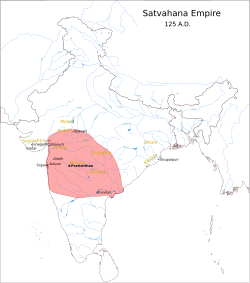Sātavāhanas
| Satavahana Empire | ||||||||||||||||
|
||||||||||||||||
|
Approximate extent of the Satavahana empire under Gautamiputra Satkarni
|
||||||||||||||||
| Capital | Pratishthana, Amaravati | |||||||||||||||
| Languages | Prakrit, Telugu | |||||||||||||||
| Religion | Brahmanism, Buddhism | |||||||||||||||
| Government | Monarchy | |||||||||||||||
| Historical era | Antiquity | |||||||||||||||
| • | Established | 1st century BCE | ||||||||||||||
| • | Disestablished | 2nd century CE | ||||||||||||||
|
||||||||||||||||
| Today part of |
|
|||||||||||||||
| Satavahana Kings (271 BCE – 220 CE) | |
| Simuka | (1st century BCE) |
| Kanha | (1st century BCE/CE) |
| Satakarni | (1st-2nd century CE) |
| Sivasvati | (1st century CE) |
| Gautamiputra Satakarni | (1st-2nd century CE) |
| Vasishthiputra Pulumavi | (2nd century CE) |
| Vashishtiputra Satakarni | (2nd century CE) |
| Shivaskanda Satakarni | (2nd century CE) |
| Yajna Sri Satakarni | (2nd century CE) |
| Vijaya | (2nd century CE) |
The Satavahanas (IAST: Sātavāhana) were an ancient Indian dynasty based in the Deccan region. Most modern scholars believe that the Satavahana rule began in first century BCE and lasted until the second century CE, although some assign the beginning of their rule to as early as the 3rd century BCE. The Satavahana kingdom mainly comprised the present-day Telangana, Andhra Pradesh and Maharashtra. At different times, their rule extended to parts of modern Gujarat, Madhya Pradesh, and Karnataka. The dynasty had different capital cities at different times, including Pratishthana (Paithan) and Amaravati (Dharanikota).
The origin of the dynasty is uncertain, but according to the Puranas, their first king overthrew the Kanva dynasty. In the post-Maurya era, the Satavahanas established peace in the Deccan region, and resisted the onslaught of foreign invaders. In particular their struggles with the Saka Western Satraps went on for a long time. The dynasty reached its zenith under the rule of Gautamiputra Satakarni and his successor Vasisthiputra Pulamavi. The kingdom fragmented into smaller states by the early 3rd century CE.
The Satavahanas were early issuers of Indian state coinage struck with images of their rulers. They formed a cultural bridge and played a vital role in trade and the transfer of ideas and culture to and from the Indo-Gangetic Plain to the southern tip of India. They supported Brahmanism as well as Buddhism, and patronised Prakrit language instead of Sanskrit.
...
Wikipedia

